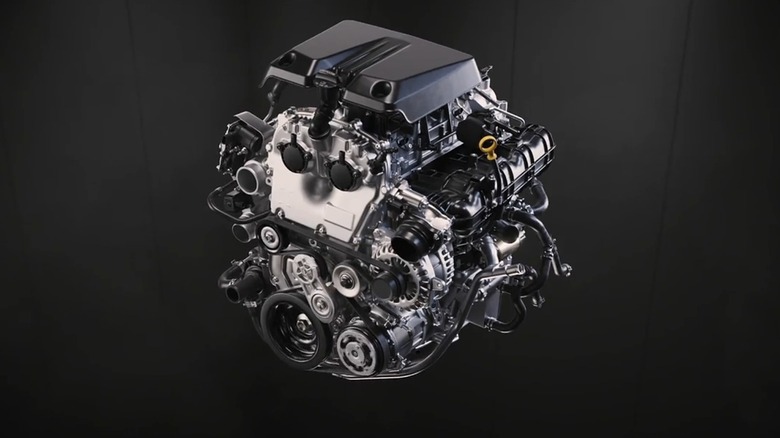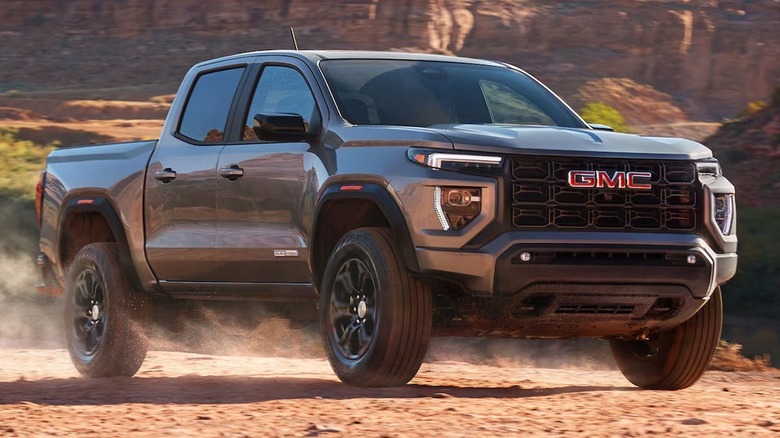What's The Real-World MPG Of A TurboMax Engine? Here's What Drivers Say
When you think of a robust American pickup truck, you probably aren't envisioning a four-cylinder under the hood. Despite that, the compact 2.7-liter TurboMax pushes out some impressive performance figures, generating 310 horsepower and 430 lb-ft of torque. We recently got an opportunity to test the turbocharged engine out in a 2025 GMC Canyon AT4, and noted that while impressive on paper, the TurboMax engine ended up feeling merely adequate. Our test of the 2025 Chevrolet Colorado, however, resulted in a much more favorable experience with the engine.
Does this compact engine offer some savings at the pump? The new two-wheel drive Canyon has an EPA estimated 19 miles per gallon city, and 23 miles per gallon highway. Other trucks that feature this engine, like the four-wheel drive Chevrolet Colorado, fared a little worse, with estimates of 17 to 18 miles per gallon city and 20 to 22 miles per gallon highway, depending on the model.
But what are everyday drivers getting in terms of fuel economy with their TurboMax engine? One Silverado owner with a TurboMax was frustrated as they only averaged 16 miles per gallon. Others have claimed to get around 17 to 19 miles per gallon in the city, and as much as 22 on the highway. However, in an interesting comparative test between GM's 5.3-liter V8 and the 2.7-liter TurboMax, one enthusiast found that the larger V8 beat out the turbo-four in city, country, and highway mileage tests.
Why isn't the TurboMax engine more fuel efficient?
There are a few reasons why GM's turbocharged four-cylinder may not be getting the mileage figures some drivers are expecting. A turbocharger compresses and moves significant amounts of air through the engine, with more air requiring more fuel. In addition, smaller turbocharged engines can suffer from something called knock. Essentially, when compared to a naturally aspirated engine, a turbocharged powerplant experiences much greater pressures and temperatures. This can lead to secondary ignition sources within the cylinder, which essentially pit multiple forces against each other during combustion.
Also, the GM engines like the 5.3-liter V8 come with Dynamic Fuel Management, which is a more advanced version of Active Fuel Management (AFM). Basically, this technology can deactivate cylinders when they're not needed and utilize a wide range of firing patterns to reduce fuel consumption. The TurboMax has AFM, although it shuts down cylinders differently than DFM-equipped V8s. The AFM feature hasn't been universally loved, though, especially on GM's larger engines, as some drivers have been looking into what AFM disablers do and whether they cause engine problems.
Why choose the TurboMax?
If you go truck shopping, one of the things you'll notice about GM's TurboMax trucks is that they're less expensive than other options. For example, the two-wheel-drive 2025 Chevy Silverado 1500 WT starts at $44,895 with the TurboMax. However, that same truck with a 5.3-liter EcoTec3 V8 retails from $46,885. Another example would be the GMC Sierra 1500, which offers a 3.0-liter Duramax Turbo Diesel option instead of the TurboMax, but at an additional cost of over $2,000.
Another reason to opt for the TurboMax is that GM has taken extra care to bolster the strength of its components to stand up to the rigors required for pickup hauling and towing. Kevin Luchangsky, the engine's assistant chief engineer, told Hagerty that the engine was "a purpose-built, turbocharged truck engine. Every detail was designed as such." GM incorporated materials for added internal strength, including rugged components such as billet steel camshafts and a reinforced aluminum block, among others. The engine's offset cylinder design also helps achieve maximum torque, helping it produce mighty levels of output, offering an additional 47 lb-ft of torque over the 5.3-liter V8.


